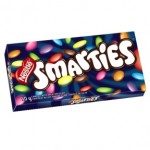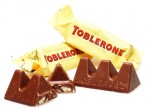Surface Area and Chocolate
Sunday, 16 August 2009 | 3 Comments
An excuse to use chocolate in a maths lesson…
Looking at Surface Area lends itself to practical activities, and two manageable activities involve chocolate.

First, find the surface area of a Smarties box. This one is not my idea, but my colleagues at school use it – it may not even be theirs; searching for smarties box reveals a couple of lesson ideas. I put together a simple worksheet as a scaffold where the students record the dimensions of the box, find the individual areas and then find the total – splitting it up allows me to find where they might have made a mistake. Once they have a reasonable answer, they get to open the box and eat – which also lets them see the net of the box used for commercial packaging. image source

We used to also use mini Toblerones which came in a triangular prism box. However, the mini Toblerones don’t come in the box anymore, but soft packaging, so I adapted the lesson. For a second activity, the students get a mini Toblerone and have to design a triangular prism box for it. The worksheet is available below. image source
Another way to include chocolate in the surface area topic is to discuss the new packaging of Cadbury’s block chocolates. They recently changed the packaging to cardboard, but at the same time they reduced the weight of the products, whilst maintaining the size. Read more on the Cadbury FAQ. This video looks at this (thanks Scott for pointing me to it):
What could you do with this video in class? At the moment, I will be using it as a discussion starter to consider how the people who designed the new packaging would have understood surface area and volume. Any better ideas?
Posted in • Lesson Idea • Surface Area • Media • Video • Printable • Worksheet • What can you do with this? | Short URL: http://mths.co/1610
Post a comment
Commenting is not available in this channel entry.New Subscribe to the …
MathsLinksemail newsletter
Get updates…
About
Simon Job — eleventh year of teaching maths in a public high school in Western Sydney, Australia.
MathsClass is about teaching and learning in a maths classroom. more→
Archive
Elsewhere
 @simonjob
@simonjob
updates via  @mathslinks
@mathslinks
Recently read/found.
Being a Vector is not Mutually Exclusive – Ringo Mok
maths vectorsInstagram
Gcf howie_hua maths
Comments